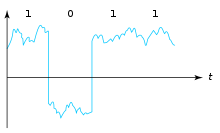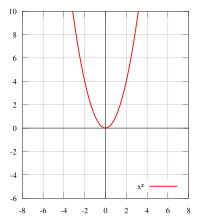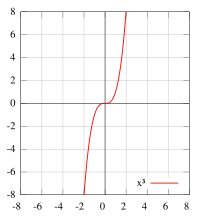Signal

Signalrefers to both the process and the result oftransmissionofdataover somemediaaccomplished by embedding some variation. Signals are important in multiple subject fields includingsignal processing,information theoryandbiology.
In signal processing, a signal is a function that conveysinformationabout a phenomenon.[1]Any quantity that can vary over space or time can be used as a signal to share messages between observers.[2]TheIEEE Transactions on Signal Processingincludesaudio,video,speech,image,sonar,andradaras examples of signals.[3]A signal may also be defined asanyobservable change in a quantity over space or time (atime series), even if it does not carry information.[a]
In nature, signals can be actions done by an organism to alert other organisms, ranging from the release of plant chemicals to warn nearby plants of a predator, to sounds or motions made by animals to alert other animals of food. Signaling occurs in all organisms even at cellular levels, withcell signaling.Signaling theory,inevolutionary biology,proposes that a substantial driver forevolutionis the ability of animals to communicate with each other by developing ways of signaling. In human engineering, signals are typically provided by asensor,and often the original form of a signal is converted to another form of energy using atransducer.For example, amicrophoneconverts an acoustic signal to a voltage waveform, and aspeakerdoes the reverse.[1]
Another important property of a signal is itsentropyorinformation content.Information theoryserves as the formal study of signals and their content. The information of a signal is often accompanied bynoise,which primarily refers to unwanted modifications of signals, but is often extended to include unwanted signals conflicting with desired signals (crosstalk). The reduction of noise is covered in part under the heading ofsignal integrity.The separation of desired signals from background noise is the field ofsignal recovery,[5]one branch of which isestimation theory,a probabilistic approach to suppressing random disturbances.
Engineering disciplines such as electrical engineering have advanced the design, study, and implementation of systems involvingtransmission,storage,and manipulation of information. In the latter half of the 20th century, electrical engineering itself separated into several disciplines:electronic engineeringandcomputer engineeringdeveloped to specialize in the design and analysis of systems that manipulate physical signals, whiledesign engineeringdeveloped to address the functional design of signals inuser–machine interfaces.
Definitions[edit]
Definitions specific to sub-fields are common:
- Inelectronicsandtelecommunications,signalrefers to any time-varyingvoltage,current,orelectromagnetic wavethat carries information.
- Insignal processing,signals are analog and digital representations of analog physical quantities.
- Ininformation theory,a signal is a codified message, that is, the sequence ofstatesin acommunication channelthat encodes a message.
- In a communication system, atransmitterencodes amessageto create a signal, which is carried to areceiverby the communication channel. For example, the words "Mary had a little lamb"might be the message spoken into atelephone.The telephone transmitter converts the sounds into an electrical signal. The signal is transmitted to the receiving telephone by wires; at the receiver it is reconverted into sounds.
- In telephone networks,signaling,for examplecommon-channel signaling,refers to phone number and other digital control information rather than the actual voice signal.
Classification[edit]
Signals can be categorized in various ways. The most common[verification needed]distinction is between discrete and continuous spaces that the functions are defined over, for example, discrete and continuous-time domains.Discrete-time signalsare often referred to astime seriesin other fields.Continuous-time signalsare often referred to ascontinuous signals.
A second important distinction is between discrete-valued and continuous-valued. Particularly indigital signal processing,adigital signalmay be defined as a sequence of discrete values, typically associated with an underlying continuous-valued physical process. Indigital electronics,digital signals are the continuous-time waveform signals in a digital system, representing a bit-stream.
Signals may also be categorized by their spatial distributions as either point source signals (PSSs) or distributed source signals (DSSs).[2]
In Signals and Systems, signals can be classified according to many criteria, mainly: according to the different feature of values, classified intoanalog signalsanddigital signals;according to the determinacy of signals, classified into deterministic signals and random signals; according to thestrength of signals,classified into energy signals and power signals.
Analog and digital signals[edit]

Two main types of signals encountered in practice areanaloganddigital.The figure shows a digital signal that results from approximating an analog signal by its values at particular time instants. Digital signals arequantized,while analog signals are continuous.
Analog signal[edit]
An analog signal is anycontinuous signalfor which the time-varying feature of the signal is a representation of some other time varying quantity, i.e.,analogousto another time varying signal. For example, in an analogaudio signal,the instantaneousvoltageof the signal varies continuously with thesound pressure.It differs from adigital signal,in which the continuous quantity is a representation of a sequence ofdiscrete valueswhich can only take on one of a finite number of values.[6][7]
The termanalog signalusually refers toelectrical signals;however, analog signals may use other mediums such asmechanical,pneumaticorhydraulic.An analog signal uses some property of the medium to convey the signal's information. For example, ananeroid barometeruses rotary position as the signal to convey pressure information. In an electrical signal, thevoltage,current,orfrequencyof the signal may be varied to represent the information.
Any information may be conveyed by an analog signal; often such a signal is a measured response to changes in physical phenomena, such assound,light,temperature,position, orpressure.The physical variable is converted to an analog signal by atransducer.For example, in sound recording, fluctuations in air pressure (that is to say,sound) strike the diaphragm of amicrophonewhich induces corresponding electrical fluctuations. The voltage or the current is said to be ananalogof the sound.
Digital signal[edit]

A digital signal is a signal that is constructed from a discrete set ofwaveformsof a physical quantity so as to represent a sequence ofdiscretevalues.[8][9][10]Alogic signalis a digital signal with only two possible values,[11][12]and describes an arbitrarybit stream.Other types of digital signals can representthree-valued logicor higher valued logics.
Alternatively, a digital signal may be considered to be the sequence of codes represented by such a physical quantity.[13]The physical quantity may be a variable electric current or voltage, the intensity, phase orpolarizationof anopticalor otherelectromagnetic field,acoustic pressure, themagnetizationof amagnetic storagemedia, etc. Digital signals are present in alldigital electronics,notably computing equipment anddata transmission.
With digital signals, system noise, provided it is not too great, will not affect system operation whereas noise always degrades the operation ofanalog signalsto some degree.
Digital signals often arise viasamplingof analog signals, for example, a continually fluctuating voltage on a line that can be digitized by ananalog-to-digital convertercircuit, wherein the circuit will read the voltage level on the line, say, every 50microsecondsand represent each reading with a fixed number of bits. The resulting stream of numbers is stored as digital data on a discrete-time and quantized-amplitude signal.Computersand otherdigitaldevices are restricted to discrete time.
Energy and power[edit]
According to the strengths of signals, practical signals can be classified into two categories: energy signals and power signals.[14]
Energy signals: Those signals'energyare equal to a finite positive value, but their average powers are 0;
Power signals: Those signals' averagepowerare equal to a finitepositivevalue, but their energy areinfinite.
Deterministic and random[edit]
Deterministic signals are those whose values at any time are predictable and can be calculated by a mathematical equation.
Random signals are signals that take on random values at any given time instant and must be modeledstochastically.[15]
Even and odd[edit]
Aneven signalsatisfies the condition
or equivalently if the following equation holds for allandin the domain of:
An odd signal satisfies the condition
or equivalently if the following equation holds for allandin the domain of:
Periodic[edit]
A signal is said to beperiodicif it satisfies the condition:
or
Where:
= fundamental timeperiod,
= fundamentalfrequency.
A periodic signal will repeat for every period.
Time discretization[edit]

Signals can be classified ascontinuousordiscrete time.In the mathematical abstraction, the domain of a continuous-time signal is the set of real numbers (or some interval thereof), whereas the domain of a discrete-time (DT) signal is the set ofintegers(or other subsets of real numbers). What these integers represent depends on the nature of the signal; most often it is time.
A continuous-time signal is anyfunctionwhich is defined at every timetin an interval, most commonly an infinite interval. A simple source for a discrete-time signal is thesamplingof a continuous signal, approximating the signal by a sequence of its values at particular time instants.
Amplitude quantization[edit]
If a signal is to be represented as a sequence of digital data, it is impossible to maintain exact precision – each number in the sequence must have a finite number of digits. As a result, the values of such a signal must bequantizedinto afinite setfor practical representation. Quantization is the process of converting a continuous analog audio signal to a digital signal with discrete numerical values of integers.
Examples of signals[edit]
Naturally occurring signals can be converted to electronic signals by varioussensors.Examples include:
- Motion.The motion of an object can be considered to be a signal and can be monitored by various sensors to provide electrical signals.[16]For example,radarcan provide an electromagnetic signal for following aircraft motion. A motion signal is one-dimensional (time), and the range is generally three-dimensional. Position is thus a 3-vector signal; position and orientation of a rigid body is a 6-vector signal. Orientation signals can be generated using agyroscope.[17]
- Sound.Since a sound is avibrationof a medium (such as air), a sound signal associates apressurevalue to every value of time and possibly three space coordinates indicating the direction of travel. A sound signal is converted to an electrical signal by amicrophone,generating avoltagesignal as an analog of the sound signal. Sound signals can besampledat a discrete set of time points; for example,compact discs(CDs) contain discrete signals representing sound, recorded at44,100 Hz;since CDs are recorded instereo,each sample contains data for a left and right channel, which may be considered to be a 2-vector signal. The CD encoding is converted to an electrical signal by reading the information with alaser,converting the sound signal to an optical signal.[18]
- Images.A picture or image consists of a brightness or color signal, a function of a two-dimensional location. The object's appearance is presented as emitted or reflectedlight,an electromagnetic signal. It can be converted to voltage or current waveforms using devices such as thecharge-coupled device.A 2D image can have a continuous spatial domain, as in a traditional photograph or painting; or the image can be discretized in space, as in adigital image.Color images are typically represented as a combination of monochrome images in threeprimary colors.
- Videos.A video signal is a sequence of images. A point in a video is identified by its two-dimensional position in the image and by the time at which it occurs, so a video signal has a three-dimensional domain. Analog video has one continuous domain dimension (across ascan line) and two discrete dimensions (frame and line).
- Biologicalmembrane potentials.The value of the signal is anelectric potential(voltage). The domain is more difficult to establish. Somecellsororganelleshave the same membrane potential throughout;neuronsgenerally have different potentials at different points. These signals have very low energies, but are enough to make nervous systems work; they can be measured in aggregate byelectrophysiologytechniques.
- The output of athermocouple,which conveys temperature information.[1]
- The output of apH meterwhich conveys acidity information.[1]
Signal processing[edit]

Signal processing is the manipulation of signals. A common example is signal transmission between different locations. The embodiment of a signal in electrical form is made by atransducerthat converts the signal from its original form to awaveformexpressed as acurrentor avoltage,orelectromagnetic radiation,for example, anoptical signalorradio transmission.Once expressed as an electronic signal, the signal is available for further processing by electrical devices such aselectronic amplifiersandfilters,and can be transmitted to a remote location by atransmitterand received usingradio receivers.
Signals and systems[edit]
Inelectrical engineering(EE) programs, signals are covered in a class and field of study known assignals and systems.Depending on the school, undergraduate EE students generally take the class as juniors or seniors, normally depending on the number and level of previouslinear algebraanddifferential equationclasses they have taken.[19]
The field studies input and output signals, and the mathematical representations between them known as systems, in four domains: time, frequency,sandz.Since signals and systems are both studied in these four domains, there are 8 major divisions of study. As an example, when working with continuous-time signals (t), one might transform from the time domain to a frequency orsdomain; or from discrete time (n) to frequency orzdomains. Systems also can be transformed between these domains like signals, with continuous tosand discrete toz.
Signals and systems is a subset of the field ofmathematical modeling.It involves circuit analysis and design via mathematical modeling and some numerical methods, and was updated several decades ago withdynamical systemstools including differential equations, and recently,Lagrangians.Students are expected to understand the modeling tools as well as the mathematics, physics, circuit analysis, and transformations between the 8 domains.
Because mechanical engineering (ME) topics like friction, dampening etc. have very close analogies in signal science (inductance, resistance, voltage, etc.), many of the tools originally used in ME transformations (Laplace and Fourier transforms, Lagrangians, sampling theory, probability, difference equations, etc.) have now been applied to signals, circuits, systems and their components, analysis and design in EE. Dynamical systems that involve noise, filtering and other random or chaotic attractors and repellers have now placed stochastic sciences and statistics between the more deterministic discrete and continuous functions in the field. (Deterministic as used here means signals that are completely determined as functions of time).
EE taxonomists are still not decided where signals and systems falls within the whole field of signal processing vs. circuit analysis and mathematical modeling, but the common link of the topics that are covered in the course of study has brightened boundaries with dozens of books, journals, etc. called "Signals and Systems", and used as text and test prep for the EE, as well as, recently, computer engineering exams.[20]
Gallery[edit]
-
A signalman sends a semaphore message from a Pearl Harbor Control Tower,c. 1960.
-
A Finnish distant signal at the western approach toMuhosstation is displayingExpect Stop.
-
A woman hailing a cab is sending a signal of availability to be picked up.
-
Aflareis a common means to signal during dark or smoke-filled conditions.
See also[edit]
- A Mathematical Theory of Communication– 1948 article on theory of communication by Claude Shannon
- Current loop– a signaling system in widespread use for process control
- Signal-to-noise ratio
Notes[edit]
References[edit]
- ^abcd
Roland Priemer (1991).Introductory Signal Processing.World Scientific. p. 1.ISBN978-9971509194.Archivedfrom the original on 2013-06-02.
A signal is a function that conveys information about the behavior of a system or attributes of some phenomenon.
- ^ab
Chakravorty, Pragnan (2018). "What Is a Signal? [Lecture Notes]".IEEE Signal Processing Magazine.35(5): 175–177.Bibcode:2018ISPM...35e.175C.doi:10.1109/MSP.2018.2832195.S2CID52164353.
Consequently, a signal, represented as a function of one or more variables, may be defined as an observable change in a quantifiable entity.
- ^ "Aims and scope".IEEE Transactions on Signal Processing.IEEE.Archivedfrom the original on 2012-04-17.
- ^Priyabrata Sinha (2009).Speech processing in embedded systems.Springer. p. 9.ISBN978-0387755809.Archivedfrom the original on 2013-06-02.
To put it very generally, a signal is any time-varying physical quantity.
- ^ T. H. Wilmshurst (1990).Signal Recovery from Noise in Electronic Instrumentation(2nd ed.). CRC Press. pp. 11ff.ISBN978-0750300582.Archivedfrom the original on 2015-03-19.
- ^"Digital signals".st-andrews.ac.uk.Archivedfrom the original on 2017-03-02.Retrieved2017-12-17.
- ^"Analog vs. Digital - learn.sparkfun".learn.sparkfun.Archivedfrom the original on 2017-07-05.Retrieved2017-12-17.
- ^Robert K. Dueck (2005).Digital Design with CPLD Applications and VHDL.Thomson/Delmar Learning.ISBN1401840302.Archived fromthe originalon 2017-12-17.
A digital representation can have only specific discrete values
- ^Proakis, John G.;Manolakis, Dimitris G.(2007-01-01).Digital Signal Processing.Pearson Prentice Hall.ISBN9780131873742.Archivedfrom the original on 2016-05-20.
- ^Smillie, Grahame (1999-04-02).Analogue and Digital Communication Techniques.Elsevier.ISBN9780080527147.Archived fromthe originalon 2017-12-17.
A digital signal is a complex waveform and can be defined as a discrete waveform having a finite set of levels
- ^"Digital Signal".Archivedfrom the original on 2019-04-02.Retrieved2016-08-13.
- ^Paul Horowitz; Winfield Hill (2015).The Art of Electronics.Cambridge University Press.ISBN9780521809269.
- ^Vinod Kumar Khanna (2009).Digital Signal Processing.S. Chand. p. 3.ISBN9788121930956.
A digital signal is a special form of discrete-time signal which is discrete in both time and amplitude, obtained by permitting each value (sample) of a discrete-time signal to acquire a finite set of values (quantization), assigning it a numerical symbol according to a code... A digital signal is a sequence or list of numbers drawn from a finite set.
- ^Sklar, Bernard, 1927– (2001).Digital communications: fundamentals and applications(2nd ed.). Upper Saddle River, N.J.: Prentice-Hall PTR.ISBN0130847887.OCLC45823120.
{{cite book}}:CS1 maint: multiple names: authors list (link) CS1 maint: numeric names: authors list (link) - ^Ziemer, Rodger E. (2014-03-17).Principles of communication: systems, modulation, and noise.Tranter, William H. (Seventh ed.). Hoboken, New Jersey.ISBN9781118078914.OCLC856647730.
{{cite book}}:CS1 maint: location missing publisher (link) - ^ For an example from robotics, see K Nishio & T Yasuda (2011)."Analog–digital circuit for motion detection based on vertebrate retina and its application to mobile robot".In Bao-Liang Lu; Liqing Zhang & James Kwok (eds.).Neural Information Processing: 18th International Conference, Iconip 2011, Shanghai, China, November 13–17, 2011.Springer. pp. 506ff.ISBN978-3642249648.Archivedfrom the original on 2013-06-02.
- ^ For example, seeM. N. Armenise; Caterina Ciminelli; Francesco Dell'Olio; Vittorio Passaro (2010)."§4.3 Optical gyros based on a fiber ring laser".Advances in Gyroscope Technologies.Springer. p. 47.ISBN978-3642154935.Archivedfrom the original on 2013-06-02.
- ^ The optical reading process is described byMark L. Chambers (2004).CD & DVD Recording for Dummies(2nd ed.). John Wiley & Sons. p. 13.ISBN978-0764559563.Archivedfrom the original on 2013-06-02.
- ^David McMahon (2007).Signals & Systems Demystified.New York: McGraw Hill.ISBN978-0-07-147578-5.Archivedfrom the original on 2020-01-22.Retrieved2017-09-11.
- ^M.J. Roberts (2011).Signals and Systems: Analysis Using Transform Methods & MATLAB.New York: McGraw Hill.ISBN978-0073380681.
Further reading[edit]
- Hsu, P. H. (1995).Schaum's Theory and Problems: Signals and Systems.McGraw-Hill.ISBN0-07-030641-9.
- Lathi, B.P. (1998).Signal Processing & Linear Systems.Berkeley-Cambridge Press.ISBN0-941413-35-7.





















